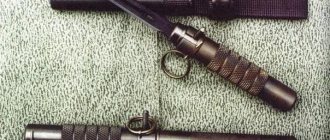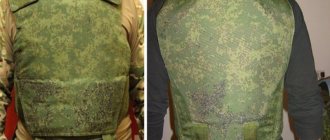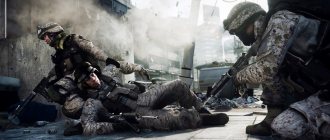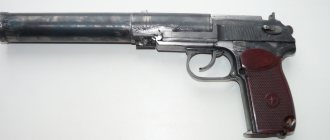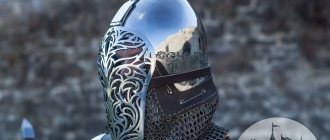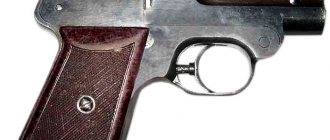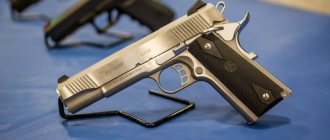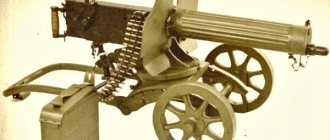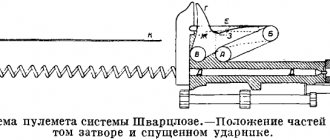Classification of personal armor protection
§1.
Concept, main characteristics of body armor, protection classes Personal body armor (PIB) is designed to protect personnel from possible injuries when exposed to firearms and bladed weapons by offenders, blows from metal rods, sticks, and thrown objects.
Personal armor protection means include:
— protective helmets;
— shockproof and bulletproof shields;
— shockproof shields to protect hands and feet;
— assault protective systems.
It should be noted that protective vests and helmets are subject to a specific set of requirements, which are defined by GOST R 50744-95 “Armored clothing. Classification and general technical requirements."
GOST gives the following definition: “Armored clothing - personal armor protection equipment, made in the form of coats, capes, raincoats, suits, jackets, trousers, overalls, vests, aprons, intended for periodic wearing in order to protect the human body from cold steel and small arms fire.” .
Armor of armored clothing is the protective structure of armored clothing, that is, “a set of protective elements that absorb and dissipate the energy of weapons, and, if necessary, a shock absorber to absorb dynamic loads, united by a common design solution in armored clothing.”
The entire variety of protective structures of armored clothing can be divided into five groups:
— textile (woven) armor;
The consumer properties of armor are characterized by the following six main parameters: level of protection; protection area; weight; thickness; price; wearing comfort.
Level of protection.
Armor is a product designed to stop bullets flying at speeds from 300 meters to 1 kilometer per second on a short path. Modern bullets are so diverse in their characteristics that certain difficulties arise with their classification. The emergence of a domestic standard (GOST R 50744-95) partially solved this problem. However, the methodology for testing bullet resistance in Russia remains insufficiently developed. The peculiarity of the requirement for armored contusion injury specified in the Russian standard - “must not exceed the second degree of severity” - involves testing on biomannequins or body simulators in the form of gelatin blocks with a complex system for recording armored processes.
In world practice, the largest number of studies and tests of personal safety equipment are carried out on mastic substrates simulating the human body. The requirements of foreign methods clearly indicate the type of backing material and the magnitude of its maximum permissible deformation, which puts armored clothing from different manufacturers in the same testing conditions. In particular, according to the US standard NIJ 0101.03, special modeling clay “ROMA N1” must be used, heated to a temperature at which the depth of the imprint of a load with a hemispherical head with a diameter of 45 mm, weighing 1 kg, dropped from a height of 1 m, is 25 ± 3 mm . The depth of the indentation on such material when testing BO should not exceed 45 mm.
Modern body armor protects against the penetrating action of a bullet, shrapnel or other foreign body. Several layers of Kevlar fabric plus ceramic or metal plates should slow it down or reduce its speed as much as possible. Body armor best resists small fragments that have low speed. A bullet is a completely different matter. If an advertisement or instruction says that a product, for example, “withstands a pistol shot,” this means that the body armor can be guaranteed to stop a bullet from a PM or TT. But it will not protect you from the consequences of its kinetic strike.
The only exceptions are special body armor that has shock-absorbing inserts and lining - they are used by army and police special forces to perform particularly dangerous tasks. However, they are bulky, weigh from 8 to 32 kilograms and also do not provide a full guarantee. In 2003, while clearing explosives in Moscow, a sapper died when his heavy armored suit could not save him from the blast wave.
Protection area.
The area of human protection by armored clothing is closely related to such parameters as user mobility and comfort. If you mentally put the term “protection area” on one side of the scale, and the user’s “mobility” and “wearing comfort” on the other, then you can balance both sides only by making a reasonable compromise. Indeed, the higher the area of protection, the lower the motor ability of a person, which is unacceptable, say, for special rapid response units, whose combat operations sometimes last a matter of seconds; it makes no sense to shackle collection teams in armor, which are in a collection vehicle for a long time and must move around for a short time. limited spaces.
Personal armor protection
Currently, personal armor protection has become an integral attribute not only of special forces and riot police, but also of the ground forces and police.
Personal armor protection (PIB) is designed to protect personnel from damage from shell and mine fragments, firearms and bladed weapons. The NIB is subject to requirements that are defined by GOST R 50744-95 “Armored clothing. Classification and general technical requirements."
TYPES OF SIB
GOST defines the types of armored clothing as follows: “Means of personal armor protection for a person, made in the form of a coat, cape, raincoat, suit, jacket, trousers, overalls, vest, apron, helmet, intended for periodic wearing, in order to protect the body from cold and firearms." Of course, “coats” and “overalls” are quite exotic means.
Mainly NIBs include:
- armored helmets - head protection; - body armor - protection of the neck, chest, back, groin; - shockproof and bulletproof armored shields - head, neck, torso and upper limbs; - armored head, neck, torso and upper limbs. - armored shields - lower limbs, upper limbs; - combat protective kits - neck, chest, back, upper and lower limbs; - safety shoes - feet, shins; — shockproof mittens and chainmail gloves — protection of hands.
According to their design, NIBs are divided by type of wear (concealed and open), by type of application (military, assault, police, civilian and special concealed carry). There are floating SIBs (for the Navy) and canine security guards (for protection from dogs).
CLASSIFICATION OF SIB ARMOR
NIB armor is formed by a set of protective elements that are designed to absorb and dissipate the energy of weapons. An important function of armor is shock absorption and damping of dynamic loads and the prevention of extra-barrier injury caused by damaging elements (bullets, shrapnel, bladed weapons). The entire variety of armor for armored clothing can be divided into five groups: textile, metal, ceramic, composite, combined. The consumer properties of armor are determined by the following parameters: level of protection, area of protection, weight, thickness, cost, wearing comfort.
What are bulletproof vests made of?
Nowadays, a variety of materials are used to make body armor. It can be a metal alloy, special ceramic plates, or high-strength fabric - the well-known Kevlar. There are also composite and combined options.
This is not to say that any of them are better than others. The bad ones are simply sorted out and consigned to the dustbin of history. The fact is that you have to pay for high security with mobility. For example, a fighter, wearing a 6B45 body armor, receives much more reliable protection than when using body armor of the 1st protection class. However, you have to pay for this - you can run with such armor, but your agility is significantly reduced.
But if you take a sapper suit, then this body armor frankly pales in comparison. This colossus reliably protects the limbs, body and head. It’s just impossible not only to run in it, but also to simply walk quickly. Of course, no one would even think of using such a machine in battle. Even if it protects against shrapnel and most bullets, due to its terrible clumsiness, sooner or later one of the dozens or even hundreds of bullets will find a vulnerable spot.
It’s probably worth talking about the different materials that are used today for the manufacture of personal armor protection in more detail.
Classification of personal armor protection
Standardization of ISS (Personal Armor Protection Equipment) , or PPE (Personal Protective Equipment) is aimed at achieving a unified order in the field of safety. For this purpose, certain rules and regulations have been developed and are intended to be universally applicable.
Objectives of NIB standardization:
- Achieving optimal regulation in the field of life safety and health of citizens.
- Creation of classification systems for armored clothing.
- Ensuring the quality of products.
- Ensuring the maximum level of development of the specialization in question.
This leads to the following standardization tasks:
- Establishment of accurate and correct standards systems that will be based on comprehensive target programs. The programs should determine the basic requirements for the design of armor protection equipment, their production technology, the necessary materials and the quality of raw materials.
- Creation of a unified system for assessing the quality of information security systems, as well as optimal methods of control and testing.
In a nutshell, standardization is necessary for the most efficient production of high-quality NIB and their further safe use.
A little history
For the first time, people began to talk about the standardization of armored clothing in 1984, when the Ministry of Defense of the Soviet Union developed “General Technical Requirements for PPE.” These requirements were not widespread in the country, because at that time they were still in effect only within the walls of this department.
The peak of popularity of NIB can be safely considered to be the late 80s - early 90s, when, due to the unfavorable situation in the country, an increasing number of consumers began to think about their safety. This combination of circumstances gave a sharp impetus to the development of standardization of armor protection. However, then it was not possible to come to a single decision, so the norms and procedures depended entirely on belonging to one or another department.
Time passed, and the country needed to develop a single, targeted set of rules and regulations in the field of personal protection. Soon the first State standard for armored clothing - GOST R 50744-95 - was put on public display. Then, together with GOST, a certification system for PPE products was created. Based on test reports and study of various types of documentation, a special certificate of conformity was issued. Today, several companies issue certificates.
Different countries have their own personal protective equipment standards. Let's consider the main types of standards:
- GOST R 50744-95 (Russia)
- NIJ (USA),
- DIN (Germany),
- CEN (European standard)
Classification of body armor and armored clothing in general
Personal armor protection equipment in different countries is classified depending on the protective properties of the armor.
US Body Armor Classes (NIJ 0101.03)
- Type I (22 LR; 380 ACP). This armor protects a person from being hit by a bullet from a 22 caliber long rifle. The first class provides protection against lead bullets with a modified tip, the mass of which does not exceed 2.6 g, the impact speed should not exceed 320 m/s. In addition to the 22 gauge, the Type I holds the 380 ACP (FMJ RN), which fires metal-jacketed bullets. The mass of bullets should not exceed 6.2 g, and the speed should not exceed 312 m/s.
- Type II A (9mm, 40 S&W). This armor protects a person from a 9 mm blunt-pointed bullet containing a metal shell. The mass of the bullet is 8.0 g, and the speed at impact is 332 m/s. In addition to the 9mm bullet, the second type of armor provides protection against a 40 S&W caliber bullet with a solid metal jacket. The mass of the bullet is 11.7 g, and the speed at impact is 312 m/s. In addition to the listed threats, this type of armor is capable of protecting the owner of the bulletproof vest from the types of weapons specified in the first paragraph.
- Type II (9mm 357 Magnum). This armor provides protection against a 9 mm blunt-pointed bullet containing a metal shell. The mass of the bullet is 8.0 g. The difference with the second class is only in the impact speed. Here its parameter is 358 m/s. In addition, a bulletproof vest helps when shooting from a 357 Magnum, where the bullet is in a soft shell. The mass of the bullet is 10.2 g, and the impact speed will be 427 m/s. Protects against threats from the first and second points.
- Type IIIA (High Velocity 9mm, 44 Magnum). This armor provides protection against a 9 mm blunt-pointed bullet containing a metal shell. The mass of the bullet is 8.0 g. The difference with the third class is only in the speed of impact of the bullet. Here its parameter is 427 m/s. In addition, the body armor saves you when shooting from a 44 Magnum with a bullet mass of 15.6 g and a speed of 427 m/s. Protects against threats from the first, second and third points.
- Type III (rifle). A special protection class designed to protect against a 7.62 mm blunt-point bullet with a metal jacket (M80). The bullet mass is 9.6 g, and the bullet impact speed is 838 m/s. This class fully complies with the requirements of the previous paragraphs.
- Type IV (armor-piercing rifle). And the last type of armor. This armor provides protection against 30 caliber armor-piercing bullets (M2 AR). The mass of such bullets is 10.8 g, and the minimum speed upon impact is 869 m/s. The fifth class provides protection against the threats that were listed in the previous paragraphs.
Special protective shields. Shield armor protection classes. Bulletproof assault shields
Shields are designed for additional protection of individual parts of the body of police officers during special events.
Types of shields: Shockproof, Bulletproof
BZT-75S
The most famous and widespread Russian small assault shield is the BZT-75S. BZT-75S has a trapezoidal shape with the plane of the metal part bending inward along the vertical axis of symmetry and with rounded corners. The metal part is inserted into a fabric cover. The armored shield is held with one hand using a rubberized metal handle and bracket attached to the back side of the shield at an angle relative to its base. BZT-75S armored shields are manufactured in two versions depending on the requirements for bullet resistance: - 3rd class of protection - 5th class of protection
Weight of the armored shield - for protection class 3 - no more than 8.5 kg - for protection class 5 - no more than 12.5 kg
The BZT-75S armored shields are widely used among special forces due to their light weight and small size, which made it possible and allows them to be successfully used during dynamic assaults on buildings (premises), when speed of movement is a priority.
FORT "Vant-LM"
The FORT Vant-LM armored shield is designed for protection during assault operations in buildings, air and railway transport. Thanks to the special design and unique armored structure, the shield provides high maneuverability and highly effective protection against bullets with a heat-strengthened core from AKM and AK-74 assault rifles, LPS bullets from the SVD rifle and bullets from the M16A1 and A2 rifles at a distance of 5 meters with a low probability of ricochet. The armor shield is equipped with a removable apron, fixed at the bottom of the shield. The apron is equipped with an armored panel that increases its protection class from 2 to 5. The total weight of the armored shield is up to 14 kg.
The design and arrangement of the handles and straps of the armored shields allows them to be held comfortably by both right and left hands. On the front side in the center of the armor shield under the fabric flap there is a bright red sticker (circle) that distracts the enemy’s attention and disorients aiming
Vant-VM
A much larger assault shield that provides protection for most of the body is the Vant-VM. This shield is based on a composite armor element of protection class 5, placed in a case. A second class 2 armor element, made of bullet-resistant polymer fiber, is attached to it from below. This apron can be easily removed if necessary. For combat use of the shield, the operator needs an unloading-shoulder suspension system. Using a harness made of belts, the fighter is able to manipulate the shield with just one hand, and use the other to wield the weapon. “Vant-VM” is equipped with a viewing slot with armored glass (the so-called visor) of the same 5th resistance class. In addition, a strip is reinforced on the outer surface of the shield, allowing the installation of various types of tactical flashlights and video cameras. Just below this bar there is a large red mark, the purpose of which is to concentrate the enemy’s attention on yourself and force him to fire directly at it, in other words, at the most protected place of the shield. The composite armor element can withstand hits from 5 m bullets from AKM, AK-74, SVD, M16A1 and M16A2. The Vant-VM assault armor shield has proven itself well in real combat conditions, and therefore is widely used by special forces of the Ministry of Defense and the Ministry of Internal Affairs.
Zabor-M
The next level of protection can be called the assault shield "". By its design, “Zabor-M” is an all-metal armor plate, in the upper part of which there is no longer a viewing slot mounted like that of “Vanta-VM”, but an entire viewing window, protected by the same multi-layer armored glass. A narrow fabric-polymer apron is attached to the lower section of the shield, protecting the legs and feet from pistol bullets and shrapnel. To carry and combat use this rather heavy and massive structure, the operator must put on a special breastplate with hooks, which include the brackets of the armor plate itself. "Zabor-M" received resistance class 5, it protects the entire surface of the body and is capable of stopping 7.62 mm AKM, SVD bullets, as well as fragments of any grenades. Not only one person, but also a small group can operate under the cover of this shield.
BASTION
Mobile shield on a chassis, 5th protection class according to GOST R 50744. The shield is equipped with 3 viewing windows with glass of 5th protection class with loopholes and a chassis for mobile movement. Weight no more than 150 kg.
10. Armored folding folders, bulletproof cases, explosion-proof blankets, protective containers, explosion localizers….
Armored folders are special-purpose products that are successfully used by security and personal protection personnel. Thanks to the use of armor plates, armored folders provide the protected person with additional protection from small arms bullets, as well as protection from grenade fragments and fragments of explosive devices
The armored folder "Secret-2" is a special-purpose protective device designed to protect unprotected (weakly protected) areas of the body from the effects of damaging factors of firearms, ammunition and explosive devices.
When folded, the armor panels are placed inside a cover that masks the contents of the folder; when unfolded, the panels form a continuous shield that can protect a significant area of the body from damage.
The mechanism for quickly unfolding the armor panels is triggered immediately after one of the folder handles is dropped from the fingers; the folder is brought to its original position by sequentially placing the armor panels in a special compartment located inside the folder. In order to prevent spontaneous operation of the folder opening mechanism as a result of sudden shaking or slipping of fingers, a fixing strap with a button is provided on one of the carrying handles.
The product retains its protective and performance properties in the temperature range from -40 °C to +40 °C, and in conditions of high humidity (up to 98%) - at temperatures up to +30 °C.
Bulletproof case
The bulletproof case is designed to protect the human body from possible injuries from small arms bullets, damaging elements of fragments from explosions, etc. Can also be used to carry documents. The bulletproof case is designed for use by bodyguards, businessmen and other civilians. The level of protection varies depending on the armor elements used and can reach class 3 - 4. There are 2 color options to choose from
The anti-fragmentation blanket "COMFORT" is designed to reduce high-explosive and fragmentation effects during the explosion of improvised explosive devices (IEDs).
The “UYUT” anti-fragmentation blanket provides a 70% reduction in fragmentation flow at a distance of 2.5 m from the epicenter during an IED explosion with a capacity of up to 400 g of TNT equivalent.
The anti-fragmentation blanket “COMFORT” is intended for use in the temperature range from -45ºС to +45ºС.
The blanket should be stored in a closed, dry room at a temperature from -30ºС to +35ºС.
The Inhibitor-1M explosion localization device is an effective and easy-to-use technical means of immediate response when objects and devices that are suspected of being explosive are detected. It ensures a reduction in the energy released during the explosion of explosive devices and, accordingly, reduces the possibility of destruction and damage from fragments, and also significantly reduces the possibility of fires.
The Fountain device allows you to localize an explosion and protect people and buildings from its effects. It is recommended for use in administrative buildings, financial institutions, train stations, airports, subways, museums, hotels and other places where there are large crowds of people and an increased risk of terrorist attacks. The product must be stored in an accessible place for prompt use. When examining an object by specialists, the device does not create interference in the X-ray range. In the event of an explosion, the device effectively suppresses its high-explosive, fragmentation and thermal effects.
Products "Fountain":
· Reduce destruction and human casualties to a minimum;
· Effectively suppress high-explosive, fragmentation, thermal and thermobaric effects of explosions;
· The pressure amplitude at the shock wave front is repeatedly reduced;
· Erase and cool the shock wave front;
· Prevent fires, thermal and thermobaric damage;
· Reduce fragmentation flow and reduce the likelihood of being hit by shrapnel.
Concept and classification of SSAO
Means of active defense - designed to repel attacks by offenders, suppress their disobedience, limit physical resistance, actively influence offenders through short-term psychophysical or painful effects without causing injuries or other bodily harm.
Means of active defense are used to influence offenders in order to deprive them of the opportunity to conduct active, purposeful actions.
This type of special means includes:
– special rubber stick (PR-73, PR-73M, PR-89, PR-90);
– handcuffs (BR, BR-S);
– hand gas grenades (“Cheryomukha-1”, “Cheryomukha-6”, “Cheryomukha-12”);
– cartridges with gas grenades (“Cheryomukha-4”, “Cheryomukha-7”);
– aerosol packaging (“Cheryomukha-10”);
– special carbine (KS-23);
– electroshock devices.
CM. lecture
12. Special rubber sticks, the history of their appearance. Modern rubber stick...
The first attempt to equip the Russian police with sticks was made on May 20, 1881 by the Minister of Internal Affairs N.P. Ignatiev, who made a report to Emperor Alexander III “On arming the lower ranks of the St. Petersburg city police with wooden clubs.” The report asked for the greatest permission to replace dragoon-style checkers with wooden clubs. Despite the emperor’s refusal to the minister, the previously made police wooden clubs were given to some officials.
A special stick is a universal tool that is indispensable in situations involving the need to control a crowd, a group of offenders or one offender
A stick is a special tool designed for active defense when repelling an attack that directly threatens the life and health of a security guard and (or) suppressing a criminal attack on protected property when the offender offers physical resistance.
When using a special stick, in accordance with clause 1 of part 2 of Article 22 of the Federal Law “On Police”, striking the head, neck, clavicular area, stomach and genitals is prohibited. These restrictions apply to the offensive nature of the use of the stick. If a stick is used as a means of defense, then according to Part 5 of Art. 22 of the Federal Law “On Police”, in a state of necessary defense, strikes can be applied at the discretion of the defender, depending on the nature and degree of danger of the attack, the strength of the attacking party, etc.
A modern rubber stick is a cast rubber rod of round cross-section, ending at one end with a hemisphere and at the other with a handle with a lanyard.
Some rubber poles have an additional perpendicular handle. Some rubber sticks have a ring protrusion (mini-guard) on the handle to improve control of the stick when striking, and also protects the fingers when a glancing blow from an enemy object hits the stick.
In addition, the protrusion serves as a stop for carrying a rubber stick in a hard case or ring near the belt.
Currently, the authorities have two modification groups of rubber sticks in their arsenal, which are intended for use in various conditions by employees of different departments of law enforcement agencies:
Group I – PR-73, PR-73M, PR-89M. Designed for use in open areas to deliver mounted and sliding blows;
Group II – PR-89, PR-90, PR-Tonfa, PR-Taran – for use in limited, cramped conditions, i.e. in road and rail transport, crowds, indoors, etc.
Depending on the length, police sticks are divided into:
− long (more than 90 cm);
− medium (46-90 cm);
− small (45-20 cm);
− ultra-small (less than 20 cm).
